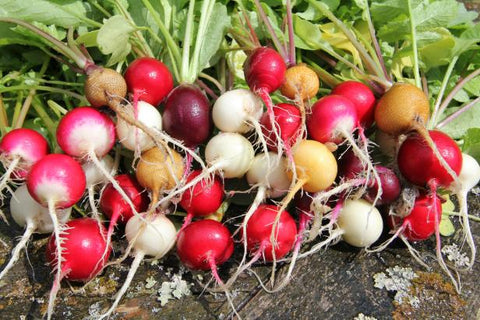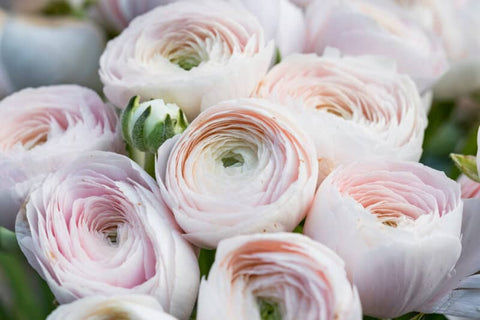Welcome to the aromatic world of fragrant herbs! As spring unfolds its petals and the air fills with the promise of new beginnings, there's no better time to cultivate a garden brimming with delightful scents and vibrant colors. In this guide, we'll explore ten fragrant herbs that will not only add olfactory pleasure to your garden but also offer a plethora of culinary, medicinal, and aesthetic benefits.

Lavender
Lavender, with its slender stems adorned with clusters of tiny purple flowers, is a sight to behold in any garden. Its distinctive aroma, reminiscent of clean linen and floral sweetness, fills the air with tranquility and relaxation.
Benefits of growing lavender
Beyond its enchanting fragrance, lavender is a versatile herb with a multitude of benefits. It possesses calming properties that soothe the mind and body, making it an ideal addition to aromatherapy rituals. Additionally, lavender is a natural insect repellent, making it a valuable companion plant in organic gardening practices.
Tips for growing lavender in your garden
To cultivate thriving lavender plants, ensure they receive plenty of sunlight and well-drained soil. Lavender thrives in dry conditions, so avoid overwatering to prevent root rot. Pruning the plant after flowering encourages bushy growth and prolongs the blooming period, allowing you to enjoy its fragrance throughout the season.
Rosemary
Rosemary, with its needle-like leaves and woody stems, is a Mediterranean herb cherished for its robust flavor and fragrant aroma. Its name, derived from the Latin "Rosmarinus," meaning "dew of the sea," reflects its affinity for coastal regions and its ability to thrive in sunny, arid conditions.
Fragrance and uses of rosemary
The invigorating scent of rosemary uplifts the spirits and stimulates the senses, making it a popular choice for culinary applications, such as seasoning roasted meats, vegetables, and bread. In addition to its culinary uses, rosemary has a long history of medicinal and ceremonial significance, symbolizing remembrance and fidelity in various cultures.
Cultivation tips for rosemary
Rosemary is well-suited to container gardening or planted directly in the ground, provided it receives full sunlight and well-drained soil. Avoid overwatering, as rosemary prefers drier conditions and is susceptible to root rot in waterlogged soil. Prune the plant regularly to maintain its shape and encourage new growth, ensuring a bountiful harvest of fragrant sprigs for culinary use.

Mint
Mint, a member of the Lamiaceae family, encompasses a diverse array of species and cultivars, each with its own unique fragrance and flavor profile. From spearmint and peppermint to chocolate mint and pineapple mint, there's a mint variety to suit every palate and culinary creation.
Fragrance and culinary uses of mint
The refreshing scent of mint, characterized by its cool, menthol aroma, adds a burst of freshness to beverages, salads, and desserts. In addition to its culinary uses, mint has a long history of medicinal use, aiding in digestion, soothing upset stomachs, and relieving respiratory congestion.
How to cultivate mint in your garden
Mint is a vigorous grower that thrives in moist, well-drained soil and partial shade. To prevent the mint from spreading uncontrollably, consider planting it in containers or designated areas of the garden, as its rhizomatous roots can quickly overtake surrounding plants. Regular harvesting of mint leaves promotes bushy growth and prevents the plant from becoming leggy, ensuring a steady supply of fragrant foliage for culinary and medicinal purposes.
Basil
Basil, with its glossy green leaves and delicate white flowers, is a beloved herb in cuisines worldwide, revered for its sweet, spicy aroma and robust flavor. Belonging to the Ocimum genus, basil encompasses numerous cultivars, including sweet basil, Thai basil, and lemon basil, each with its own distinct fragrance and culinary applications.
Fragrance and culinary applications of basil
The aromatic essence of basil, reminiscent of cloves and anise, infuses dishes with depth and complexity, making it a staple ingredient in Italian pasta sauces, pesto, and Caprese salads. Beyond its culinary uses, basil boasts antimicrobial properties and is rich in antioxidants, promoting overall health and well-being when incorporated into the diet
Growing basil: essential tips
Basil thrives in warm, sunny conditions with well-drained soil and regular watering. To encourage compact growth and prevent flowering, pinch off the top leaves of basil plants regularly, allowing the plant to focus its energy on producing flavorful foliage. Consider planting basil alongside tomatoes, peppers, and eggplants, as it enhances the flavor of these companion plants and deters pests such as aphids and whiteflies.
Thyme
Thyme, with its tiny leaves and delicate flowers, is a versatile herb prized for its aromatic fragrance and medicinal properties. Belonging to the Thymus genus, thyme encompasses numerous species and cultivars, including common thyme, lemon thyme, and creeping thyme, each with its unique flavor profile and culinary uses.
Fragrance and medicinal properties of thyme
The warm, herbal scent of thyme evokes images of sun-drenched hillsides and Mediterranean cuisine, infusing dishes with earthy complexity and savory depth. In addition to its culinary uses, thyme has a long history of medicinal use, with antiseptic and antifungal properties that make it a valuable ally in natural healing remedies.
Guidelines for growing thyme successfully
Thyme thrives in well-drained soil and full sunlight, making it an excellent choice for rock gardens, borders, and container plantings. To encourage dense growth and prolonged flowering, prune thyme regularly, removing dead or woody stems and spent flowers. Consider companion planting thyme alongside rosemary, lavender, and sage, as it complements their fragrance and enhances their flavor.

Lemon Balm
Lemon balm, with its heart-shaped leaves and citrusy aroma, is a delightful addition to any garden, offering a multitude of culinary, medicinal, and aromatic benefits. Belonging to the Melissa genus, lemon balm is a member of the mint family and shares its vigorous growth habit and aromatic foliage.
Fragrance and uses of lemon balm
The refreshing scent of lemon balm uplifts the spirits and invigorates the senses, making it a popular choice for teas, cocktails, and culinary creations. In addition to its culinary uses, lemon balm possesses calming properties that soothe nerves, promote relaxation, and improve sleep quality when consumed as a tea or incorporated into aromatherapy rituals.
Cultivation tips for lemon balm in your garden
Lemon balm thrives in moist, well-drained soil and partial shade, making it an ideal candidate for shady garden beds, borders, and containers. To contain lemon balm's vigorous growth and prevent it from spreading uncontrollably, consider planting it in pots or using barriers to restrict its roots. Regular harvesting of lemon balm leaves promotes bushy growth and ensures a steady supply of fragrant foliage for culinary and medicinal use.
Sage
Sage, with its velvety leaves and pungent aroma, is a versatile herb prized for its culinary, medicinal, and ornamental value. Belonging to the Salvia genus, sage encompasses numerous species and cultivars, including common sage, pineapple sage, and purple sage, each with its own distinct flavor profile and culinary uses.
Fragrance and culinary uses of sage
The earthy fragrance of sage evokes images of autumn harvests and cozy kitchen gatherings, infusing dishes with warmth and depth of flavor. In addition to its culinary uses, sage boasts antimicrobial properties that make it a valuable ingredient in natural remedies for sore throats, coughs, and digestive ailments.
How to grow sage effectively
Sage thrives in well-drained soil and full sunlight, making it an excellent choice for garden beds, borders, and container plantings. To encourage compact growth and prolong flowering, prune sage regularly, removing spent flowers and woody stems. Consider companion planting sage alongside rosemary, thyme, and lavender, as it complements their fragrance and enhances their flavor.

Chamomile
Chamomile, with its dainty white flowers and apple-like aroma, is a soothing herb cherished for its calming effects and gentle healing properties. Belonging to the Matricaria genus, chamomile encompasses two main species: German chamomile (Matricaria chamomilla) and Roman chamomile (Chamaemelum nobile), each with its own distinct fragrance and medicinal benefits.
Fragrance and medicinal benefits of chamomile
The sweet scent of chamomile promotes relaxation, relieves stress, and induces restful sleep, making it a popular choice for teas, tinctures, and aromatherapy blends. In addition to its calming effects, chamomile possesses anti-inflammatory and antispasmodic properties that soothe digestive discomfort, menstrual cramps, and skin irritations when consumed or applied topically.
Cultivation advice for chamomile in your garden
Chamomile thrives in well-drained soil and full sunlight, making it an excellent choice for sunny garden beds, borders, and containers. To encourage continuous blooming and prevent self-seeding, deadhead chamomile regularly, removes spent flowers before they set seed. Consider companion planting chamomile alongside lavender, calendula, and yarrow, as it complements their fragrance and enhances their medicinal properties.
Rose Geranium
Rose geranium, with its fragrant leaves and delicate flowers, is a charming addition to any garden, offering a multitude of culinary, cosmetic, and aromatic benefits. Belonging to the Pelargonium genus, rose geranium is a member of the geranium family and shares its vigorous growth habit and colorful blooms.
Fragrance and uses of rose geranium
The floral scent of rose geranium uplifts the mood and enhances the ambiance of any space, making it a popular choice for potpourri, sachets, and homemade cosmetics. In addition to its aromatic uses, rose geranium possesses astringent and anti-inflammatory properties that make it a valuable ingredient in skincare products for balancing oil production, reducing inflammation, and promoting healthy, radiant skin.
Growing rose geranium: essential guidelines
Rose geranium thrives in well-drained soil and full sunlight, making it an excellent choice for sunny garden beds, borders, and containers. To encourage compact growth and abundant flowering, prune rose geranium regularly, removing spent flowers and leggy stems. Consider companion planting rose geranium alongside lavender, rosemary, and sage, as it complements their fragrance and enhances their aesthetic appeal.

Lemongrass
Lemongrass, with its tall, slender stalks and citrusy aroma, is a versatile herb prized for its culinary, medicinal, and aromatic qualities. Belonging to the Cymbopogon genus, lemongrass encompasses several species, including Cymbopogon citratus and Cymbopogon flexuosus, each with its own distinct flavor profile and culinary uses.
Fragrance and culinary uses of lemongrass
The invigorating scent of lemongrass adds zest to dishes, teas, and infusions, making it a popular choice for Asian cuisine, herbal remedies, and refreshing beverages. In addition to its culinary uses, lemongrass possesses antimicrobial and anti-inflammatory properties that support immune health, digestive wellness, and overall well-being when consumed as a tea or incorporated into culinary creations.
Tips for successfully cultivating lemongrass
Lemongrass thrives in moist, well-drained soil and full sunlight, making it an excellent choice for garden beds, borders, and containers. To encourage vigorous growth and prevent overcrowding, space lemongrass plants at least two feet apart and provide adequate airflow between them. Consider companion planting lemongrass alongside basil, mint, and cilantro, as it complements their fragrance and enhances their flavor.
Conclusion
As you embark on your herbal journey, may the fragrant blooms and aromatic foliage of these ten herbs infuse your spring garden with vitality, joy, and endless inspiration. Whether you're a seasoned gardener or a novice enthusiast, cultivating fragrant herbs is a rewarding experience that nourishes the body, mind, and soul. So roll up your sleeves, dig in the dirt, and let the scent of spring guide you on a botanical adventure filled with beauty, flavor, and fragrant delights. Happy gardening!









